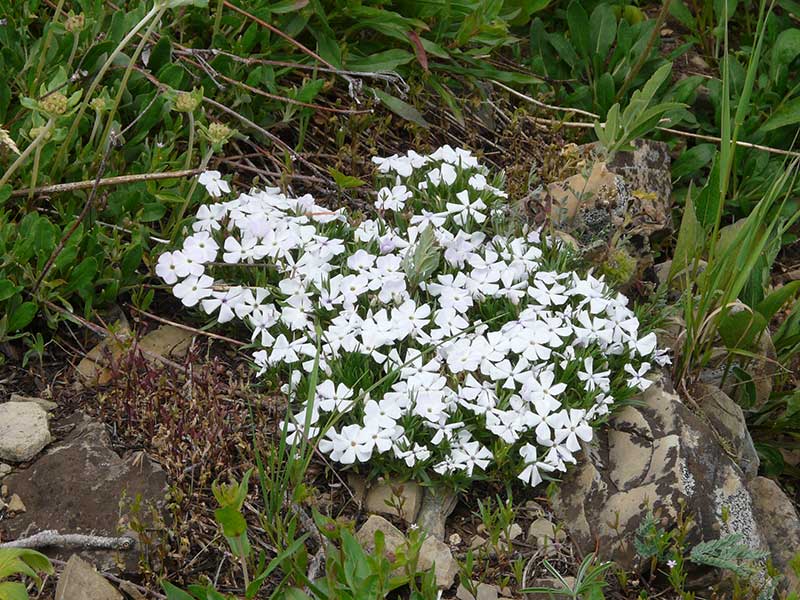Phlox diffusa / spreading phlox
- low, spreading, moss-like (before blooming)
- flowers 5-petaled, a variety of colors, and with a tube below the petals
- many habitat types incl. mountain slopes, rocky terrain, dry forests or with sagebrush
- blooms in early spring to early summer
- confusable with P. hoodii
See also: Phlox hoodii / spiny phlox
Phlox diffusa is a spring flowerer, not long after snow melt, but flowering continues through early summer. It is found in many types of habitat, including rocky, high elevation mountain slopes, open dry forests or with sagebrush. Spreading phlox is considered to be stress-tolerant species with slow leaf turnover. Starting with early spring growth being rapid, the growth and reproductive strategy of this species is basically to mature before surrounding vegetation shades it.
Spreading phlox is a mat-forming perennial herb, usually forming a tight mat or loose clump on the ground. It grows from from a woody base (caudex). It has tiny pointed leaves with sharp tips (but not as sharp as spiny phlox). The branches have short internodes, making them dense with leaves. With this, it almost looks like moss until it blooms. Over winter, it looks brown and dead as the previous year’s leaves remain on the plant while the new leaves grow above them.
The flowers of spreading phlox are 5-petaled and solitary at the ends of stems. The petals may overlap making the flowers look round. The flowers may be white, as in the present examples, or more commonly pale pink or blue or lavender (depending partly on who taught you your colors). In any case, the flowers get lighter with age. The petals are united at the base and form a tube about as long as the flower is wide.
P diffusa is pollinated by butterflies and moths, and some long-tongued bees. This suggests that cross pollination is important. There is probably some seed banking, but the extent and importance are unclear.
One of the major difficulties in identifying this species is the strong resemblance of P. diffusa to P. hoodii (spiny phlox). The US Wildflowers website lists the following potential differences:
- P. hoodii may be more common at lower elevations; P. diffusa at higher elevations.
- P. hoodii mounds rarely grow higher than 4 inches above the ground; P. diffusa may be as high as 8 inches.
- P. hoodii is a somewhat later blooming species, usually starting in late spring (in the Valley, I would put this the other way around)
- P. hoodii is more densely hairy, having woolly stems and leaf bases. The calyx of P. diffusa is smooth; that may not be the case with P. hoodii.
- P. diffusa will have solitary blossoms at the end of the branchlets. P. hoodii may have up to three flowers at the end of a branchlet.
In any case, I think that the example here is indeed P. diffusa.
| Color | |
|---|---|
| Family | |
| Blossom size | |
| Inflorescence size | |
| Inflorescence type | |
| When? | |
| Where? | exposed, higher altitudes, rocky areas, widespread, with sagebrush |


